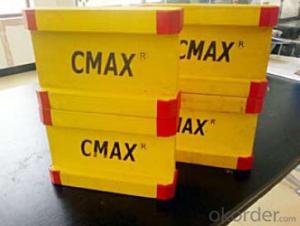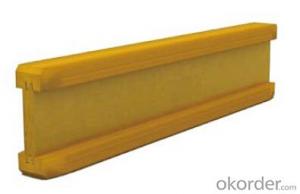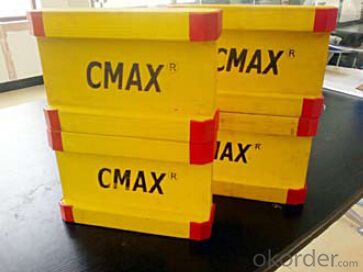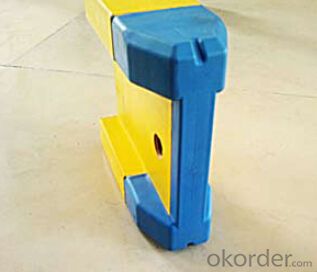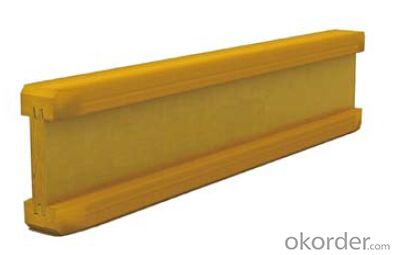Timber-Beam Formwork for building construction
- Loading Port:
- Tianjin
- Payment Terms:
- TT OR LC
- Min Order Qty:
- 50 m²
- Supply Capability:
- 1000 m²/month
OKorder Service Pledge
Quality Product, Order Online Tracking, Timely Delivery
OKorder Financial Service
Credit Rating, Credit Services, Credit Purchasing
You Might Also Like
Characteristics:
◆ Standardized production lines.
Supply capability: 3000m/day, Lmax = 6600mm.
◆ Finger jointing of the flange and web, the strength of timber beam is highly improved.
Max. shearing force failure load:40KN
◆ Well treated to prevent from water penetration or erosion, so the service life maximally
extended.
Normally, CNBM timber beam H20 can be used for 4 to 5 years, the exact using time would
depend on maintenance & storage.
◆ Robust caps at the end of the girders protect against damages.
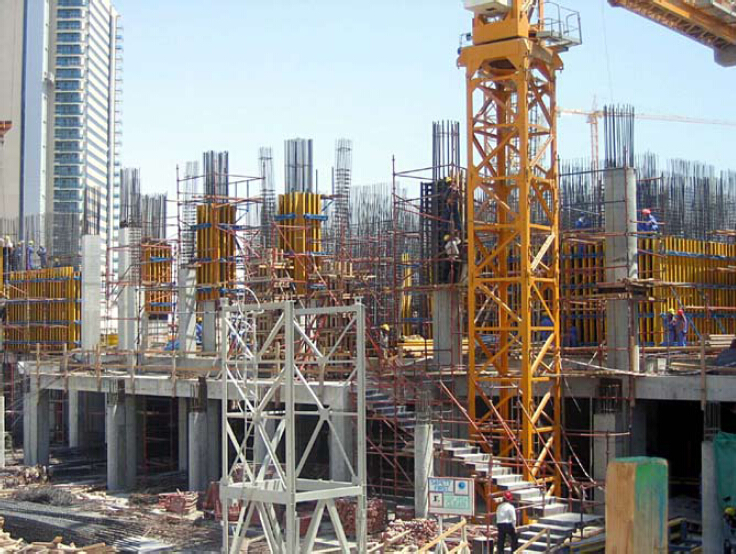
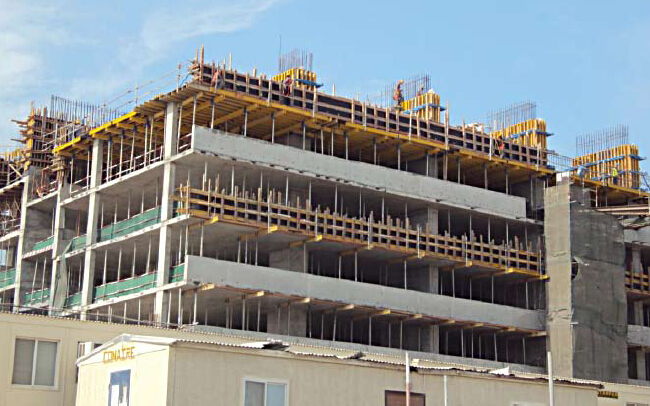
- Q: What are the different types of accessories used with steel formwork?
- Steel formwork is commonly enhanced with various accessories to improve its functionality and effectiveness in construction projects. Some examples of these accessories are: 1. Formwork Wedges: These small wedges, made of steel or plastic, secure the formwork panels together. They preserve accurate alignment and stability of the formwork system when concrete is poured. 2. Formwork Clamps: Designed to hold the formwork panels in place, clamps prevent any movement or displacement during concrete pouring and curing. They are typically steel and come in different sizes and designs to accommodate various formwork needs. 3. Formwork Ties: Ties connect the formwork panels and provide structural stability to the system. Available in steel or plastic and in different lengths and types (such as snap ties, wedge ties, and loop ties), they reinforce the formwork. 4. Formwork Braces: Steel braces reinforce and strengthen the formwork system. They support the panels, preventing bending or deformation during concrete pouring. 5. Formwork Hangers: These adjustable steel hangers suspend the formwork panels at the desired height, providing support. They can accommodate different formwork heights and configurations. 6. Formwork Spacers: Spacers maintain uniform spacing between formwork panels, ensuring consistent thickness in concrete walls or slabs. They are available in various sizes and shapes, made of plastic or steel. 7. Formwork Release Agents: These agents prevent concrete from adhering to the formwork surface. Before pouring concrete, they are applied to the panels, allowing for easy removal once the concrete has cured. Overall, these accessories are vital for maintaining the stability, alignment, and functionality of steel formwork systems. They contribute to the efficiency and quality of construction projects by providing reliable support and reinforcement during concrete pouring.
- Q: What are the typical safety precautions when working with steel formwork?
- To ensure the safety of workers and prevent accidents, it is important to adhere to various safety measures when working with steel formwork. These measures include: 1. Personal Protective Equipment (PPE): Workers must wear the appropriate PPE, such as hard hats, safety goggles, gloves, and steel-toed boots, to protect themselves from falling objects, flying debris, and foot injuries. 2. Training: Workers should receive proper training on the safe use of steel formwork and be aware of the potential hazards associated with the equipment. They should also be educated on proper lifting techniques and the handling of heavy steel components. 3. Inspection: Before commencing work, a thorough inspection of the steel formwork should be conducted to identify any defects, damage, or weak points. Any faulty or worn-out components must be replaced immediately to prevent accidents or collapses. 4. Secure Anchoring: It is crucial to securely anchor the steel formwork to prevent shifting or collapsing during construction activities. Sufficient bracing and supports should be in place to ensure stability and avoid unexpected movements. 5. Proper Handling and Lifting Techniques: Workers should employ appropriate lifting techniques when handling heavy steel components to prevent strains, back injuries, or accidents. The use of mechanical aids, such as cranes, hoists, or forklifts, should be considered to minimize the risks associated with manual handling. 6. Fall Protection: When working at heights, appropriate fall protection measures, such as guardrails, safety harnesses, or safety nets, should be utilized to prevent falls and injuries. 7. Communication and Signage: Clear communication among workers is vital to avoid accidents. Adequate signage should be displayed to indicate the presence of steel formwork, potential hazards, and restricted areas. 8. Regular Maintenance: Regular maintenance and inspections of the steel formwork should be carried out to ensure its structural integrity. Any identified issues should be promptly addressed to prevent accidents or failures. 9. Emergency Preparedness: Workers should be familiar with the emergency procedures in place, including the location of first aid kits, fire extinguishers, and evacuation routes. Regular drills and training sessions should be conducted to ensure workers are prepared for potential emergencies. By adhering to these safety precautions, the risk of accidents, injuries, and property damage when working with steel formwork can be significantly reduced, thereby creating a safer working environment for all involved.
- Q: What are the main components of a steel formwork system?
- The primary constituents of a steel formwork system include steel panels, walers, stiffeners, and connectors. 1. Steel panels serve as the fundamental elements of a steel formwork system. Typically crafted from high-quality steel, they come in assorted sizes and shapes. These panels possess the requisite strength and rigidity required to hold the concrete in position during the construction process. They are designed for easy assembly and disassembly, facilitating efficient utilization across diverse construction projects. 2. Walers, which are horizontal beams or rods, are employed to connect and brace the steel panels. They aid in distributing the concrete load and provide additional strength to the formwork system. Walers are commonly constructed from steel or timber and are situated along the edges of the formwork to preserve its shape and prevent deformation. 3. Stiffeners, vertical or diagonal elements, are integrated into the steel formwork system to enhance stability and resistance against lateral forces. Typically fashioned from steel, these stiffeners are positioned at regular intervals to offer additional support and prevent buckling or twisting of the formwork system. Stiffeners are indispensable in ensuring the safety and integrity of the formwork during concrete pouring and curing. 4. Connectors are employed to securely fasten the steel panels and other components of the formwork system. They encompass various types of bolts, nuts, clamps, or pins. Connectors play a pivotal role in maintaining formwork alignment and stability, guaranteeing its ability to withstand the pressure exerted by wet concrete. They are designed to be easily adjustable and removable, facilitating swift assembly and disassembly of the formwork system. Overall, a steel formwork system consists of steel panels, walers, stiffeners, and connectors. These constituents collaborate to furnish the requisite strength, stability, and flexibility necessary for constructing concrete structures. The utilization of steel in the formwork system ensures durability, reusability, and ease of assembly, rendering it a favored choice within the construction industry.
- Q: Can steel formwork be used in marine construction projects?
- Yes, steel formwork can be used in marine construction projects. Steel is a durable and strong material that can withstand the harsh conditions of marine environments, such as saltwater, waves, and corrosion. It can be used for various applications in marine construction, including the construction of docks, piers, offshore platforms, and other marine structures. The use of steel formwork ensures a stable and reliable construction process, providing long-lasting and robust structures in marine settings.
- Q: What are the typical environmental considerations when using steel formwork?
- When using steel formwork, there are several typical environmental considerations that need to be taken into account. Firstly, the production of steel requires a significant amount of energy and natural resources. This means that the extraction of raw materials and the manufacturing process can contribute to environmental degradation, including the emission of greenhouse gases. To mitigate these impacts, it is important to consider the use of recycled or reclaimed steel whenever possible. This helps reduce the demand for new steel production and minimizes the environmental footprint associated with the formwork. Another important consideration is the waste generated during the construction process. Steel formwork can produce a significant amount of waste, such as offcuts and discarded pieces. Proper waste management practices, such as recycling or reusing these materials, should be implemented to minimize the environmental impact. Additionally, the transportation of steel formwork can contribute to carbon emissions and air pollution. It is important to optimize transportation routes and modes to reduce the distance traveled and choose more sustainable transportation options, such as rail or water, whenever feasible. Furthermore, the use of steel formwork can have an impact on the site where construction takes place. The installation and removal of the formwork can disturb the natural environment, leading to soil erosion and habitat destruction. Implementing erosion control measures and minimizing the footprint of the formwork can help mitigate these impacts. Lastly, the longevity and durability of steel formwork should be considered. If properly maintained and reused, steel formwork can have a long lifespan, reducing the need for frequent replacement and ultimately reducing waste and resource consumption. Overall, when using steel formwork, it is important to consider the entire lifecycle of the material and implement sustainable practices to minimize its environmental impact. This includes using recycled steel, managing waste properly, optimizing transportation, mitigating site disturbance, and promoting durability and reuse.
- Q: Can steel formwork be used for both residential and commercial construction projects?
- Certainly, both residential and commercial construction projects can utilize steel formwork. This option is known for its versatility and durability in creating concrete structures, such as walls, columns, beams, and slabs. With its high load-bearing capacity, dimensional accuracy, and reusability, steel formwork proves to be suitable for various construction projects. In residential construction, it can be employed for building foundations, retaining walls, and even for crafting decorative elements. As for commercial projects, steel formwork is applicable in constructing office buildings, shopping malls, industrial facilities, and other large-scale structures. Moreover, steel formwork enables faster construction and enhances quality control, leading to time and cost savings for both residential and commercial projects.
- Q: How does steel formwork affect the overall thermal performance of the building?
- Steel formwork can have a significant impact on the overall thermal performance of a building. The thermal performance of a building refers to its ability to effectively regulate heat transfer between the interior and exterior environments. One key aspect of steel formwork that affects thermal performance is its conductivity. Steel is a highly conductive material, meaning it can easily transfer heat. This can result in higher heat transfer rates between the inside and outside of the building, which can lead to increased energy consumption for heating and cooling. Additionally, steel formwork can create thermal bridging. Thermal bridging occurs when there is a continuous path of high thermal conductivity, such as steel, that allows heat to bypass insulation. This can result in localized areas of heat loss or gain, reducing the overall effectiveness of insulation and compromising the thermal performance of the building. To mitigate these issues, various strategies can be employed when using steel formwork. One approach is to incorporate thermal breaks into the formwork system. Thermal breaks are insulating materials that are placed between the steel and the concrete, reducing the conductivity and minimizing thermal bridging. This helps to maintain a more consistent temperature throughout the building envelope and improves overall energy efficiency. Another strategy is to augment the insulation system by adding additional insulation layers to compensate for the heat transfer through the steel formwork. This can be done by applying insulation materials over the formwork or incorporating insulating layers within the concrete structure itself. Overall, while steel formwork can potentially have a negative impact on the thermal performance of a building, proper design considerations and the use of insulation and thermal break systems can help mitigate these effects and ensure a more energy-efficient and comfortable indoor environment.
- Q: Can steel formwork be used for structures with complex geometries?
- Structures with complex geometries can indeed utilize steel formwork. The versatility of steel formwork allows for easy customization to match the specific shape and dimensions of the structure. Its strength, durability, and flexibility are well-known attributes, making it suitable for constructing intricate designs and complex geometries. Steel formwork systems can be adjusted, assembled, and disassembled to create unique architectural elements and complex structural configurations. Furthermore, steel formwork guarantees a smooth and precise finish, ensuring the accuracy and quality of the final structure. In conclusion, steel formwork is a dependable and efficient choice for constructing structures with complex geometries.
- Q: Can steel formwork be used for both regular and irregular concrete structures?
- Both regular and irregular concrete structures can be constructed using steel formwork. Steel formwork is extremely versatile and can be easily tailored to fit any shape or size of the structure. This makes it suitable for constructing both regular structures with standard dimensions and irregular structures with unique shapes and designs. The flexibility of steel formwork allows for efficient construction of various types of concrete structures, such as walls, columns, beams, slabs, and even intricate architectural features. Moreover, steel formwork provides high strength and durability, ensuring that it can withstand the pressure and weight of the concrete during the pouring and curing process, regardless of the structure's regular or irregular shape. In summary, steel formwork is a dependable and adaptable option for constructing both regular and irregular concrete structures.
- Q: Can steel formwork be used for projects with high concrete durability demands?
- Projects with high concrete durability demands can indeed utilize steel formwork. Steel formwork possesses strength, durability, and longevity, rendering it appropriate for challenging construction projects. It can endure heavy loads and offer the essential support for concrete during the curing process. Moreover, steel formwork guarantees outstanding dimensional stability, thereby ensuring the precision and uniformity of the concrete structure. Furthermore, steel formwork's reusability helps minimize waste and project expenses. Nevertheless, it is crucial to adequately maintain and safeguard the steel formwork against corrosion to optimize its durability and guarantee long-lasting functionality.
Send your message to us
Timber-Beam Formwork for building construction
- Loading Port:
- Tianjin
- Payment Terms:
- TT OR LC
- Min Order Qty:
- 50 m²
- Supply Capability:
- 1000 m²/month
OKorder Service Pledge
Quality Product, Order Online Tracking, Timely Delivery
OKorder Financial Service
Credit Rating, Credit Services, Credit Purchasing
Similar products
Hot products
Hot Searches
